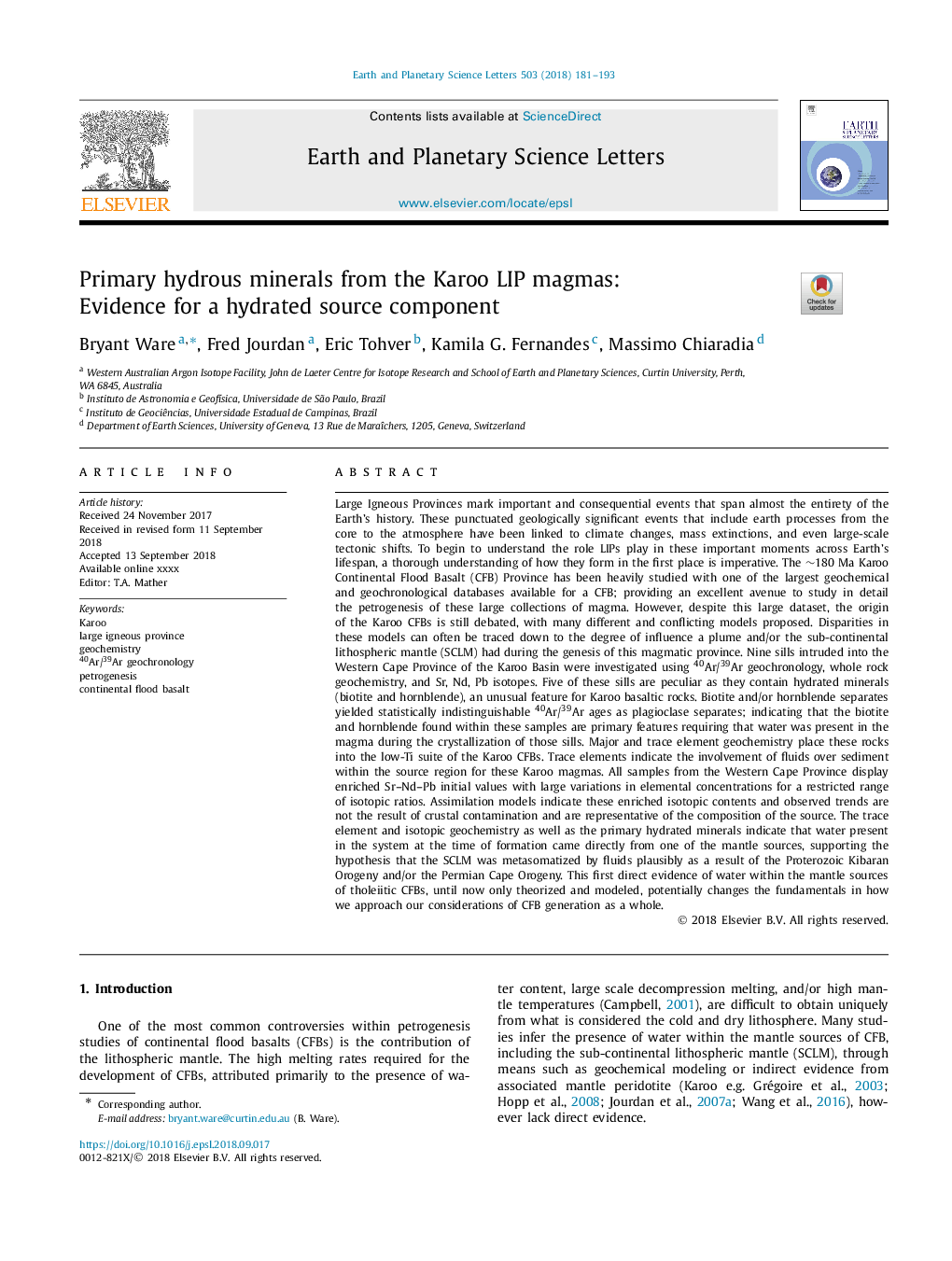| کد مقاله | کد نشریه | سال انتشار | مقاله انگلیسی | نسخه تمام متن |
|---|---|---|---|---|
| 11024699 | 1701088 | 2018 | 13 صفحه PDF | دانلود رایگان |
عنوان انگلیسی مقاله ISI
Primary hydrous minerals from the Karoo LIP magmas: Evidence for a hydrated source component
دانلود مقاله + سفارش ترجمه
دانلود مقاله ISI انگلیسی
رایگان برای ایرانیان
کلمات کلیدی
موضوعات مرتبط
مهندسی و علوم پایه
علوم زمین و سیارات
علوم زمین و سیاره ای (عمومی)
پیش نمایش صفحه اول مقاله

چکیده انگلیسی
Large Igneous Provinces mark important and consequential events that span almost the entirety of the Earth's history. These punctuated geologically significant events that include earth processes from the core to the atmosphere have been linked to climate changes, mass extinctions, and even large-scale tectonic shifts. To begin to understand the role LIPs play in these important moments across Earth's lifespan, a thorough understanding of how they form in the first place is imperative. The â¼180 Ma Karoo Continental Flood Basalt (CFB) Province has been heavily studied with one of the largest geochemical and geochronological databases available for a CFB; providing an excellent avenue to study in detail the petrogenesis of these large collections of magma. However, despite this large dataset, the origin of the Karoo CFBs is still debated, with many different and conflicting models proposed. Disparities in these models can often be traced down to the degree of influence a plume and/or the sub-continental lithospheric mantle (SCLM) had during the genesis of this magmatic province. Nine sills intruded into the Western Cape Province of the Karoo Basin were investigated using 40Ar/39Ar geochronology, whole rock geochemistry, and Sr, Nd, Pb isotopes. Five of these sills are peculiar as they contain hydrated minerals (biotite and hornblende), an unusual feature for Karoo basaltic rocks. Biotite and/or hornblende separates yielded statistically indistinguishable 40Ar/39Ar ages as plagioclase separates; indicating that the biotite and hornblende found within these samples are primary features requiring that water was present in the magma during the crystallization of those sills. Major and trace element geochemistry place these rocks into the low-Ti suite of the Karoo CFBs. Trace elements indicate the involvement of fluids over sediment within the source region for these Karoo magmas. All samples from the Western Cape Province display enriched Sr-Nd-Pb initial values with large variations in elemental concentrations for a restricted range of isotopic ratios. Assimilation models indicate these enriched isotopic contents and observed trends are not the result of crustal contamination and are representative of the composition of the source. The trace element and isotopic geochemistry as well as the primary hydrated minerals indicate that water present in the system at the time of formation came directly from one of the mantle sources, supporting the hypothesis that the SCLM was metasomatized by fluids plausibly as a result of the Proterozoic Kibaran Orogeny and/or the Permian Cape Orogeny. This first direct evidence of water within the mantle sources of tholeiitic CFBs, until now only theorized and modeled, potentially changes the fundamentals in how we approach our considerations of CFB generation as a whole.
ناشر
Database: Elsevier - ScienceDirect (ساینس دایرکت)
Journal: Earth and Planetary Science Letters - Volume 503, 1 December 2018, Pages 181-193
Journal: Earth and Planetary Science Letters - Volume 503, 1 December 2018, Pages 181-193
نویسندگان
Bryant Ware, Fred Jourdan, Eric Tohver, Kamila G. Fernandes, Massimo Chiaradia,